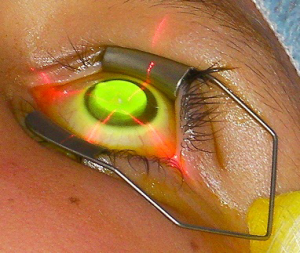The original cross-linking procedure (commonly referred to as the ‘Dresden protocol’ or ‘standard cross-linking’ [1]) involves anaesthetising the eye (for example with proxymetacainhydrochloride 0.5% drops), removing the central 8-10 mm of the epithelium and applying a riboflavin solution (0.1% riboflavin-5-phosphate and 20% dextran T-500) to the corneal surface for 30 minutes. The cornea is then exposed to 370 nm UVA with an irradiance of 3 mWcm-2 for 30 minutes, during which time riboflavin is re-applied at 5 minute intervals. After treatment, antibiotic eye drops are applied and a therapeutic soft contact lens with good oxygen transmissibility placed upon the eye to decrease pain without decreasing the quality of the regrowing epithelium. Application of topical antibiotics is required for 1 week after the operation and mild steroids may also be prescribed. Patients are usually pain-free within 5-7 days when the contact lens is removed [2].
Although this technique has been proven to be an effective means of halting keratoconus progression [3], its clinical drawbacks are the postoperative discomfort associated with removal of the corneal epithelium, the lengthy treatment time and its unsuitability for the treatment of very thin keratoconus corneas (less than 400 microns) [4].
[1] Wollensak, G. et al. Riboflavin/ultraviolet-a-induced collagen crosslinking for the treatment of keratoconus. American Journal of Ophthalmology. 2003;135:620-627.
[2] Abad, J. and Panesso, J. Corneal collagen cross-linking induced by UVA and riboflavin (CXL). Techniques in Ophthalmology. 2008;6:8-12.
[3] O’Brart DPS, et al. Corneal Cross-linking to Halt the Progression of Keratoconus and Corneal Ectasia: Seven-Year Follow-up. American Journal of Ophthalmology. 2015; 160: 1154–1163
[4] Spoerl, E. et al. Safety of UVA-Riboflavin Cross-Linking of the Cornea. Cornea. 2007;26(4):385-9.

